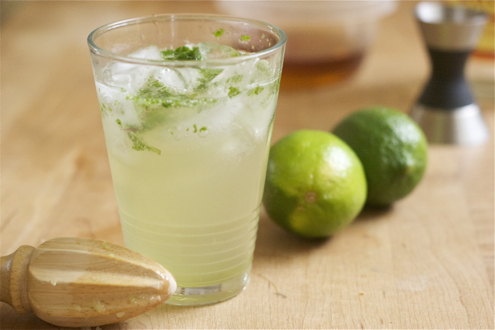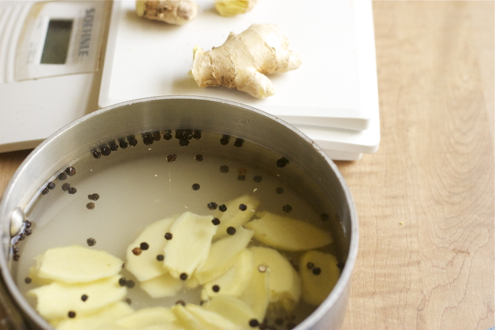 What does a person, who mostly writes about dinner, eat for breakfast? One might well wonder. I guess I’m a creature of serially monogamous breakfast habits. Obviously I like variation at dinnertime, but not in the morning. Years and years of eating the same thing for breakfast over and over again feels just right to me.
What does a person, who mostly writes about dinner, eat for breakfast? One might well wonder. I guess I’m a creature of serially monogamous breakfast habits. Obviously I like variation at dinnertime, but not in the morning. Years and years of eating the same thing for breakfast over and over again feels just right to me.
Right after college it was peanut butter and bitter marmalade on an English muffin and a cafe au lait. My roommate and I brewed these up in our Bialetti Moka Express on the funky Harvest Gold stovetop in our Russian Hill apartment. I think I ate that for breakfast for maybe ten or fifteen years. Then there were a few years, maybe four or so, of poached eggs on toast. With a cup of Murchie’s Empress Afternoon Blend tea and a glass of orange juice. That was in the Pacific Heights apartment. After I met Martin, we ate boiled eggs with this kind of weird, pink, caviar paste. It came in a bright blue tube with a smiling, little, blond boy on the front. That phase didn’t last too long. I love Martin but that pink caviar is only ok. It doesn’t hold a candle to peanut butter and marmalade.
On trips to Sweden to see Martin’s family, I discovered all kinds of cultured milk. Kefir, filmjölk, all kinds of yogurt, quark, fresh cheeses. There began a long period of variations on yogurt for breakfast. Initially this led to making my own yogurt for awhile. Then kefir finally became available in the U.S., that was really exciting! (Yes, I do live in cave.) Lastly, Greek yogurt finally arrived, the richest, thickest, most luxurious of all. Martin started making a deeply toasted muesli with dried cherries. I got stuck on that with the Greek yogurt for a long, long time. Later, switching it up with honey, raspberries, some ground walnuts and a squirt of lemon juice, was heaven.
When winter rolls around though, raspberries become ludicrous. They fly in from South America and I think “oh – how fresh and so exotic in the wintertime” but they’ve travelled miles to get to Seattle, and taste as if they’ve been around the block a few times. For something so mediocre, they cost the earth. I tried the bags of frozen local berries but quickly tired of them.
Fortunately, a few weeks ago, in a little plastic box pushed out of sight behind the toaster and leftover from a wintery Sticky Toffee Pudding: I remembered – Medjool dates! (What?! You’ve never had Sticky Toffee Pudding? I will remedy that by posting the recipe at some point…) Their deep fruity caramel flavors are in perfect counterpoint to the brightly sour yogurt. Toasted walnuts left from a grapefruit salad added complex bitterness. I confess my sweet tooth doesn’t allow plain old yogurt: I needed something sweet. Dark Grade B maple syrup – we always have that in the fridge. Maple + dates are made for each other– I will have to figure out a dessert with those two some day. The crown on this breakfast though, is the salt. A small but decisive pinch of kosher sea salt provides a glittering, edgy crunch. Perfection.
I think I will eat this until I am old and grey.
Yogurt with Dates, Toasted Walnuts, Maple Syrup and Sea Salt
- 3/4 cup yogurt – read the ingredients list – there should be no additives, nothing to thicken it but the bacteria. My yogurt (Straus) has non-fat milk, buttermilk and the yogurt cultures. I also like the European Style Organic Plain Yogurt from Trader Joe’s
- 2 tbsp grade B maple syrup
- 2-3 tbsp (about 7 walnut halves) toasted for 10 minutes at 350. (I would toast at least a cup or so at a time)
- 3 medjool dates, with pits, pitted. (Pitting is easy and I think the dates with pits taste better)
- a pinch of Kosher sea salt (I like this one, as you may already know)
This is hardly a recipe, but here’s what I do:
- Take the kids to the school. Return home and take a deep breath. Take 15 minutes for breakfast.
- You’ll want your favorite bowl. I like a deep round one because it fits so nicely into the palm of my hand when I sit eating on the couch with the newspaper but I have a fond recollection of my mother-in-law’s wide soup plates. Soup plates work better on a table though. It’s your choice. Put the yogurt in the bowl.
- Drizzle 2 tbsp maple syrup over the yogurt (I have to confess I kind of love it when I “accidentally” pour in too much…shhh)
- With a small sharp knife, make a lengthwise slit down the dates. Push out the pit. I like the dates quartered the long way. Scatter them with the walnuts over the yogurt and maple syrup.
- Take that decisive ( not too much and not too little) pinch of kosher sea salt and strew it over the yogurt dates and walnuts.
- Get a soup spoon and sit comfortably somewhere, eating this magnificent yet simple breakfast, reading the paper, gathering your thoughts, then finally getting on with things.




























